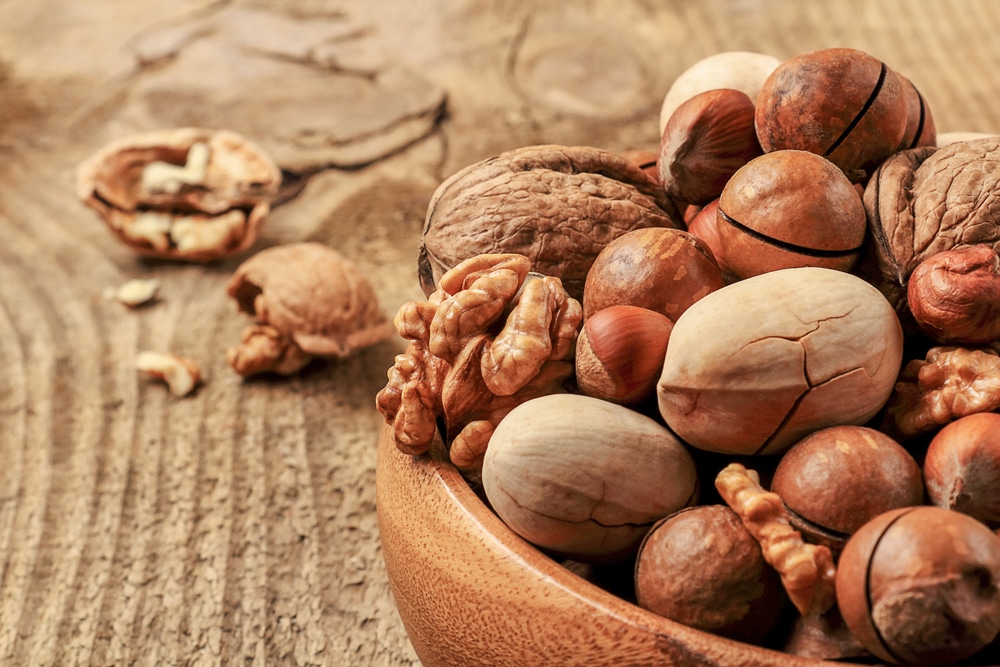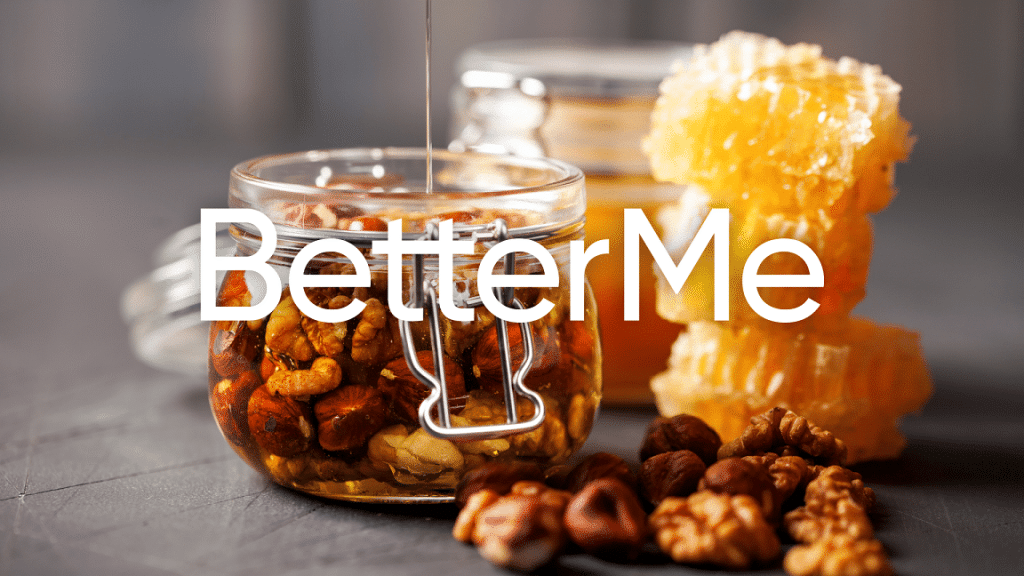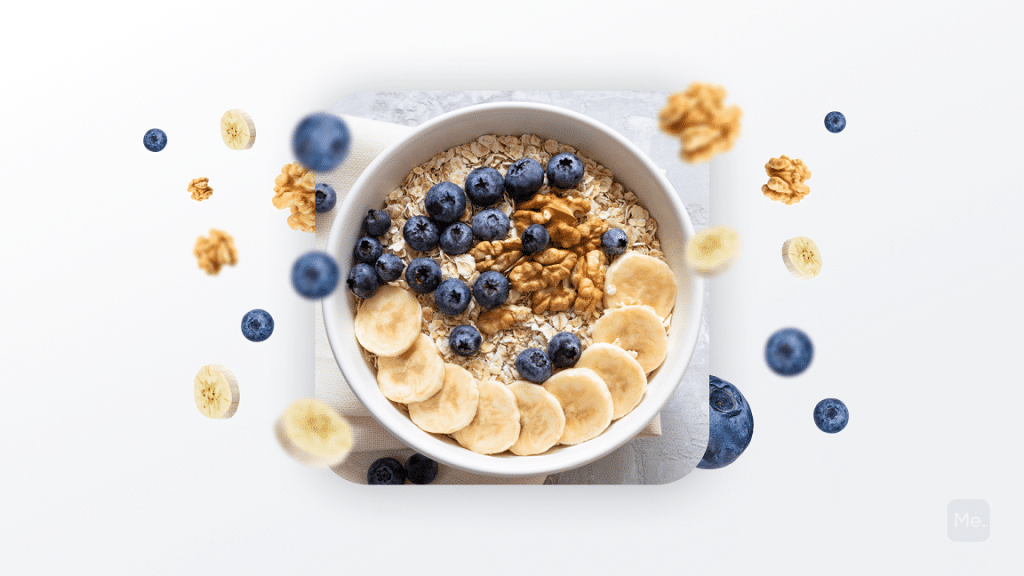When it comes to nuts, there are two that are among the most popular: pecans vs. walnuts. They’re both healthy in their own ways, but they also have some pretty significant differences between them. The first thing you should know is that while both nuts offer a good dose of heart-healthy fats, each has its own unique mix of nutrients to offer as well. Let’s take a look at these two delicious choices and see which one might be the best for your next snack!
Pecans Vs. Walnuts Nutrition Facts
Let’s take a look at how pecans and walnuts stack up in terms of nutritional content.
According to the USDA, 1 ounce of pecans has the following nutrients (10):
- Calories: 196
- Fat: 20 g
- Saturated fat: 1.8 g
- Cholesterol: 0 g
- Sodium: 0 mg
- Potassium: 116 mg
- Carbohydrates: 3.9 g
- Dietary fiber: 2.7 g
- Sugar: 1.1 g
- Protein: 2.6 g
According to the USDA, 1 ounce of walnuts has the following nutrients (11):
- Calories: 185
- Fat: 18 g
- Saturated fat: 1.7 g
- Cholesterol: 0 g
- Sodium: 0.6 mg
- Potassium: 125 mg
- Carbohydrates: 3.9 g
- Dietary fiber: 1.9 g
- Sugar: 0.7 g
- Protein: 4.3 g
For starters, pecans are considered by some to be the healthier choice when compared to walnuts because they contain more vitamins, minerals, and antioxidants than do walnuts. Pecans are rich in B6, manganese, calcium, potassium, copper, vitamin E (alpha-tocopherol), thiamine (vitamin B1), zinc, and phosphorus. Unlike most nuts which contain phytic acid that inhibits the absorption of certain nutrients found in them such as iron, phosphorus, magnesium, zinc, etc. The phytic acid content in pecans is low enough to be of negligible significance.
Walnuts, on the other hand, contain more omega-3 fatty acids. Omega-3 fatty acids are associated with a lower risk of heart disease and stroke, as well as decreased inflammation in conditions such as arthritis. In addition to oleic acid (an omega-9 fatty acid), walnuts contain alpha-linolenic acid which is an essential nutrient that can only be obtained from food or supplements (15).
They’re also rich in monounsaturated fats, vitamin E (tocopherol), and many antioxidants including resveratrol and polyphenols. However, they do contain small amounts of phytic acid which can reduce the absorption of iron and various other minerals (12).
Read More: Pecan Nuts Facts, Calories, Health Benefits And Side Effects
Pecans Vs. Walnuts: Health Benefits
Both pecans and walnuts offer several benefits when it comes to your health. These include:
Improved Heart Health
Both types of nuts are rich in monounsaturated fats which can help to lower LDL (bad) cholesterol while keeping HDL (good) cholesterol levels high. Walnuts contain slightly more potassium than do pecans, which is an essential mineral that keeps the heart beating at a steady rhythm and helps balance out sodium in our bodies (6).
The monounsaturated and polyunsaturated fatty acids within pecans and walnuts have been shown to reduce triglyceride levels, increase HDL cholesterol, lower blood pressure, strengthen capillary walls, reduce inflammation throughout the body, decrease markers for oxidative stress and lower the risk of developing chronic diseases such as heart disease (5).
Fight Inflammation
Like omega-3 fatty acids, antioxidants found in both types of nuts (but especially walnuts) have been shown to fight inflammation (14). The resveratrol and polyphenols found in walnuts have also been associated with a reduction in pain and swelling related to arthritis as well as other inflammatory conditions.
Enhanced Brain Function
Both pecans and walnuts are rich in the B vitamin thiamine which help metabolize carbohydrates into energy your brain can use (9). They’re also both good sources of manganese, which is needed for healthy nerve function, bone formation, blood clotting, and metabolism regulation (8). Pecans contain more thiamine than walnuts while walnuts contain more manganese than pecans.
Cancer Prevention
Walnuts in particular contain the potent antioxidant ellagic acid (7). This substance is found in both nuts as well as berries, grapes, and pomegranates. It has been shown (in the lab) to protect cells from cancer-causing damage due to oxidative stress as well as halting tumor growth by blocking new blood vessel growth required for additional cancer cell nutrition.
EGCG, which is found in green tea has also been linked with a reduction in various types of cancer including breast, prostate, liver, skin, and colon cancers. These substances appear to work synergistically together to have a powerful effect on cancer cells by blocking their proliferation (3).
Help Control Hunger And Cravings
Many of the healthy fats found in pecans and walnuts can help to slow down digestion which can help you feel fuller for a longer period. This includes monounsaturated fats, omega-3 fatty acids, and fiber from both sources (13). In addition, the phytic acid content of these nuts is low enough not to have significant anti-nutrient activity so they will not adversely affect your ability to absorb nutrients from other foods you eat throughout the day.
Improved Digestive Health
Walnuts contain more fiber than pecans by weight but the type of fiber in each source differs slightly. Pecans have a higher amount of insoluble fiber while soluble fiber is found in equal amounts between both nuts.
Insoluble fibers do not dissolve in water but rather do absorb it like a sponge, which can make you feel fuller for longer. Insoluble fiber aids digestion by moving food through your digestive tract more quickly so waste can be excreted from the body (2).
Soluble fiber, on the other hand, dissolves in water and turns into a gel-like substance within the gut which helps to slow down digestion. Soluble fiber is also fermented by the bacteria in your gut and tends to be associated with lower blood cholesterol levels as well as improved heart health. Pectin is one source of soluble fiber found in pecans while mucilage is another (2).
Looking for a way to break the vicious cycle of weight loss and tone up all the jiggly parts? Watch the extra pounds fly off and your muscles firm up with the BetterMe app!
Pecans Vs. Walnuts: Side Effects
As with all natural products that we put into our bodies, there are always going to be some side effects associated with each one of them if we take in too much of a good thing.
May Increase Oxidative Stress
Both pecans and walnuts are rich in omega-3 fatty acids which, like all polyunsaturated fats, become rancid when exposed to heat and oxygen such as during roasting or processing.
This process produces substances called lipid peroxides that can increase oxidative stress throughout the body and create free radicals which damage cells and DNA with long-term exposure leading to chronic disease (4). These substances have been linked to conditions such as cancer, heart disease, and various types of inflammatory disorders. If you want to avoid this potential issue, eat your nuts raw.
May Trigger Allergic Reactions
Both pecans and walnuts are considered tree nuts and can trigger serious allergic reactions in those who are sensitive to them. If you are allergic to any other type of nut, your doctor may advise you to avoid all nuts, because they may contain similar allergens or be processed on the same equipment, leading to cross-contamination.
Read More: Pine Nuts Facts, Calories, Health Benefits And Side Effects
High-Calorie Consumption
Pecans and walnuts are high in calories. Both types contain about 70% fat per ounce.
These nutrients can provide some benefits to your health but eating too much of them can add a significant number of calories to your diet which can result in weight gain if you aren’t burning off the extra energy (6).
All nuts are high in fat so take care not to overdo it on any one specific nut or type. The recommended portion size of nuts in general is 1 ounce. If you find it difficult to control your portion sizes when eating them straight out of the bag or in a dish, try mixing in some fresh berries instead.
Nutrient Deficiencies
Additionally, walnuts contain a small amount of phytic acid which can bind to certain minerals including zinc and iron which may result in deficiencies (12). It is suggested that you don’t consume large amounts of these foods regularly if you are at risk for developing nutrient deficiencies associated with low levels of these nutrients in the diet. For most people, this shouldn’t be an issue if you are consuming reasonable portions of nuts as part of an overall balanced and nutritious diet.
The Bottom Line
Based on the research, it appears that both walnuts and pecans have many health benefits as well as some potential side effects. The key to incorporating nuts into your diet is to eat them in moderation which could mean only consuming 1-2 ounces per day or less depending on what you’re trying to accomplish with a specific diet.
Get your personalized
meal plan!
DISCLAIMER:
This article is intended for general informational purposes only and does not address individual circumstances. It is not a substitute for professional advice or help and should not be relied on to make decisions of any kind. Any action you take upon the information presented in this article is strictly at your own risk and responsibility!
SOURCES:
- Antinutritional properties of plant lectins – ScienceDirect (2004 sciencedirect.com)
- Dietary fibre in foods: a review (2012, ncbi.nlm.nih.gov)
- Epigallocatechin gallate, ellagic acid, and rosmarinic acid perturb dNTP pools and inhibit de novo DNA synthesis and proliferation of human HL-60 promyelocytic leukemia cells: Synergism with arabinofuranosylcytosine (2015, sciencedirect.com)
- Evaluating the rancidity and quality of discarded oils in fast food restaurants (2019, onlinelibrary.wiley.com)
- Fatty acid composition of nuts – implications for cardiovascular health | British Journal of Nutrition | Cambridge Core (2006, cambridge.org)
- Health Benefits of Nut Consumption (2010, mdpi.com)
- Health benefits of walnut polyphenols: An exploration beyond their lipid profile (2015 pubmed.ncbi.nlm.nih.gov)
- Manganese in Health and Disease (2019, ncbi.nlm.nih.gov)
- Neurological, Psychiatric, and Biochemical Aspects of Thiamine Deficiency in Children and Adults (2019, frontiersin.org)
- Nuts, pecans (2019, fdc.nal.usda.gov)
- Nuts, walnuts, english (2019, fdc.nal.usda.gov)
- Phytate in foods and significance for humans: Food sources, intake, processing, bioavailability, protective role and analysis (2009 onlinelibrary.wiley.com)
- review of the effects of nuts on appetite, food intake, metabolism, and body weight (2014, academic.oup.com)
- Role of Antioxidants and Natural Products in Inflammation (2016, hindawi.com)
- Walnuts (Juglans regia) Chemical Composition and Research in Human Health (2015, tandfonline.com)











